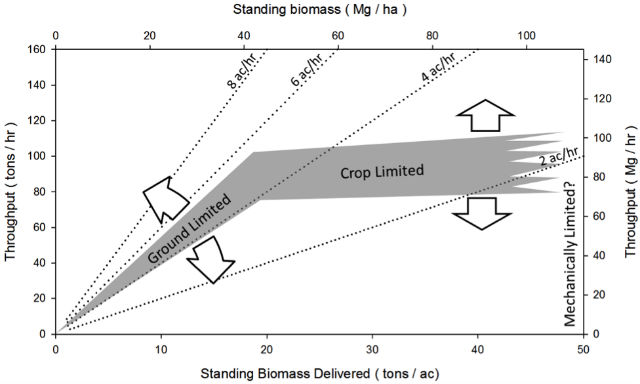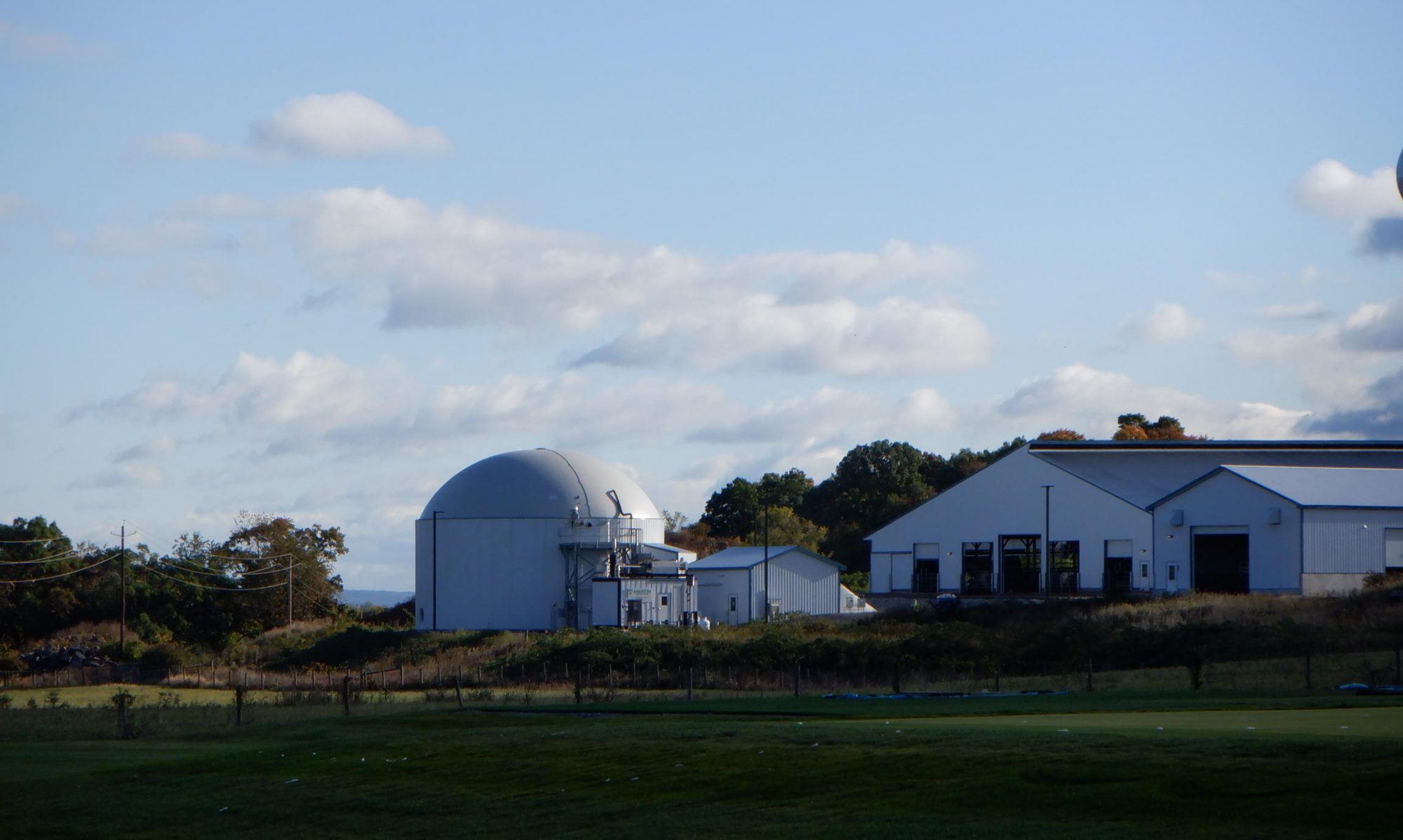
Woody biomass throughput is tripled using a new single-pass cut-and-chip harvesting system. Operator experience, crop characteristics, ground conditions, and speed all affect throughput.
Table of Contents
- Introduction
- Research Purpose
- Research Activities
- What We Have Learned
- Why This Is Important
- For More Information
- Contributors to This Summary
Introduction
Many types of specialized machinery for harvesting short rotation woody crops (SRWC) exist, including small and large single-pass cut-and-chip systems, whole stem harvesters, and baling systems. However, due to the limited scale of SRWC deployment, evolving technology, different operational scales, and management objectives, there is presently no dominant harvesting system in use. In New York State, several existing or modified harvesting platforms for SRWC from Europe and North America have been evaluated since 2001 for use in short rotation willow. Technical hurdles encountered on various harvesters that were tested during that time include the durability of equipment, low production rates, irregular feeding of stems into the harvester, limits on maximum stem sizes, and inconsistent size and quality of chips.

Research Purpose
In 2008, Case New Holland (CNH) began developing a prototype short rotation coppice header (130FB) for their FR9000 series of forage harvesters, specifically designed to cut and chip a range of SRWC such as willow, poplar, and eucalyptus (see image right). The header can easily be attached to a standard New Holland forage harvester without modifications. The performance objectives of the harvesting platform include the ability to harvest double rows of woody plants containing stems up to 4.75 in (120 mm) in diameter, and to produce chips that are 0.4 to 1.75 in (10 to 45-mm) long. Chipped material should be of a quality that allows it to be transported directly to a variety of end users for conversion to different forms of renewable energy and co-products without requiring further processing.
Research Activities
Over the course of the project, the New Holland harvesting platform was developed and tested on willow and poplar biomass crops. Time motion data was collected using GPS tracking equipment and then analyzed to assess the harvester’s performance and provide insights on how the harvesting system could be improved.
What We Have Learned
Throughput from the single-pass cut-and-chip harvesting system has improved from less than 22 wet tons/hr (20 wet Mg/hr) with well over 25% downtime due to material jams or mechanical problems, to throughputs of 77 to 99 wet tons/hr (70 to 90 wet Mg/hr) in willow biomass crops with standing biomass ranging from 9 to 29 tons/ac (20 to 65 Wet Mg/ha). The harvester can run consistently in these conditions with less than 10% downtime.

Harvests of approximately 150 acres (60 ha) of willow biomass crops during late 2012 and early 2013 in New York State and 50 acres (20 ha) of poplar biomass in Western Oregon revealed some interesting and important patterns associated with the New Holland harvesting system. The throughput of the harvester is related to the quantity of standing biomass of the crop, but the pattern differs as the amount of standing biomass changes (Figure 2). At low levels of standing biomass, throughput increases in a linear trend until standing biomass reaches approximately 20 to 22 wet tons/ac (45 to 50 wet Mg/ha). In this range of standing biomass, the throughput of the harvester is below its capacity because the speed of the harvester is limited by conditions in the field. If speeds are too high, the harvester becomes difficult to handle and it begins to pull plants out of the ground before the stems are cut. Beyond 20 to 22 wet tons/ac (45 to 50 wet Mg/ha) of standing biomass, the harvester throughput begins to plateau around 77 to 99 wet tons/hr (70 to 90 wet Mg/hr). Operator experience, characteristics of the woody crop being harvested (such as stem morphology and size), and ground conditions also appear to be important factors that influence maximum throughput at various levels of standing biomass.
Why This Is Important
Harvesting is the single largest cost component of willow biomass production and the single largest source of in-field fossil energy demand and related greenhouse gas emissions. Efforts to reduce harvesting costs by improving the performance and reliability of the harvester are essential to the profitability of woody biomass crops. In addition, having a reliable and commercially available harvesting system that is supported by a major agricultural equipment manufacturer increases the confidence level of potential project developers and producers that willow biomass crops can be grown and harvested effectively.
Harvester throughput relative to speed is often reported as the key parameter when describing harvester performance in coppice systems. Previous studies have suggested that harvester throughput in SRWC can be increased by simply maximizing harvesting speed. However, many of these studies operated in trials with crops with low standing biomass. The results from current research show that overall there is a nonlinear relationship between standing biomass and harvester throughput. This result has important implications for cost modeling SRWC systems, matching equipment to specific SRWC crops, and the optimization of field activities.
Results from these harvesting trials and product development work have successfully led to New Holland making the FB130 short rotation coppice header commercially available through its network of dealers.
For More Information
Timothy Volk (315-470-6774, tavolk@esf.edu)
Eisenbies M, T Volk, J Posselious, C Foster, S Shi, S Karapetyan. Evaluation of a single-pass, cut-and-chip harvest system on commercial-scale short-rotation shrub willow plantations. BioEnergy Research, June, 2014.
Contributors to This Research Summary
This work was supported by the US Department of Energy Biotechnologies Office, New York State Energy Research and Development Authority (NYSERDA), Empire State Development Division of Science, Technology, and Innovation (NYSTAR), and USDA AFRI.
Authors
- Mark Eisenbies, Research Scientist, SUNY College of Environmental Science and Forestry
- Timothy Volk, Senior Research Associate, SUNY College of Environmental Science and Forestry
- John Posselius, Case New Holland America
Peer Reviewer
- Jingxin Wang, West Virginia University
 The Northeast Woody/Warm-season Biomass Consortium – NEWBio is supported by Agriculture and Food Research Initiative Competitive Grant no. 2012-68005-19703 from the USDA National Institute of Food and Agriculture.
The Northeast Woody/Warm-season Biomass Consortium – NEWBio is supported by Agriculture and Food Research Initiative Competitive Grant no. 2012-68005-19703 from the USDA National Institute of Food and Agriculture.
Led by Penn State University, NEWBio includes partners from Cornell University, SUNY College of Environmental Science and Forestry, West Virginia University, Delaware State University, Ohio State University, Rutgers University,  USDA’s Eastern Regional Research Center, and DOE’s Oak Ridge National Laboratory and Idaho National Laboratory.
USDA’s Eastern Regional Research Center, and DOE’s Oak Ridge National Laboratory and Idaho National Laboratory.
